The IBM POWER8 Review: Challenging the Intel Xeon
by Johan De Gelas on November 6, 2015 8:00 AM EST- Posted in
- IT Computing
- CPUs
- Enterprise
- Enterprise CPUs
- IBM
- POWER
- POWER8
Taking a Closer Look At IBM's S822L
The S822L was mounted in the Xeon server dominated racks inside our experimental datacenter. The build quality of both the rails and server were apparent, a "locking mechanism" made sure the server was easy to mount without a screwdriver and was kept firmly at its place.
The system booted by using the Flexible Service Processor (FSP), which is comparable to the Baseboard Management Controllers as they are both components that allow you to manage and monitor your server thanks to the IPMI specification. The main difference with Xeon system is that the FSP and its related firmware and software is the only way you can control your system. There is no "BIOS" screen or BIOS configuration setup, everything has to be configured and booted via the FSP software. You could say that the "BIOS" and "BMC management software" are now integrated into one central firmware.
To power on the S822L, you have to access the FSP using the open-source IPMItool. Once the server is booted up, the "petitboot" bootloader of OPAL (the OpenPOWER Abstraction Layer firmware) takes over. It scans all bootable instances (disks, network, optical, etc.) for operating systems, and is similar to the GRUB bootloader. From there, you can install Linux like you would on an x86 system.
The cover was covered with a lot of interesting service information about the upgrading and replacing the hardware.
Once we removed the cover, lots of expansion slots became visible.
No less than nine hot plug (!) low profile PCIe Gen 3 slots are available. Four of them are x16, ready for some GPU action. Five are x8. Only one of the PCIe slots is used for the standard quad-gigabit Ethernet adapter. We also had one Emulex FC card installed.
Also installed were two PowerPC based SAS RAID controller(s), capable of RAID-6 and all common RAID levels, which connectto a dual backplane that offers 12 Small Factor Form (2.5 inch) drives. These drives can be SAS SSD or hard disks, which is a reliable but rather expensive storage choice. A DVD drive was also present, which allowed us to install Linux the old-fashioned way.
At the back we find two hot-swappable PSUs, four gigabit Ethernet interfaces, two USB 2.0 ports, an HMC dual-gigabit interface (an HMC is a hardware applicance that can manage several IBM servers) and one system port.
The server is powered by two redundant high quality Emerson 1400W PSUs.


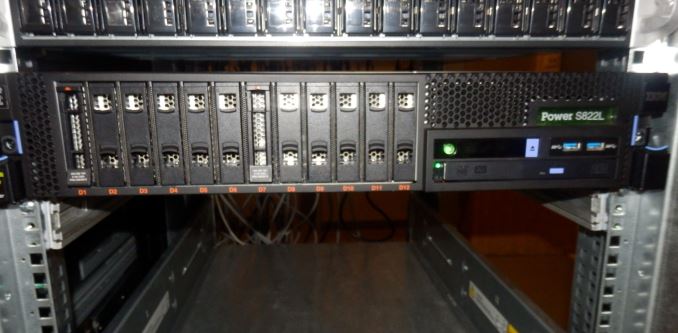
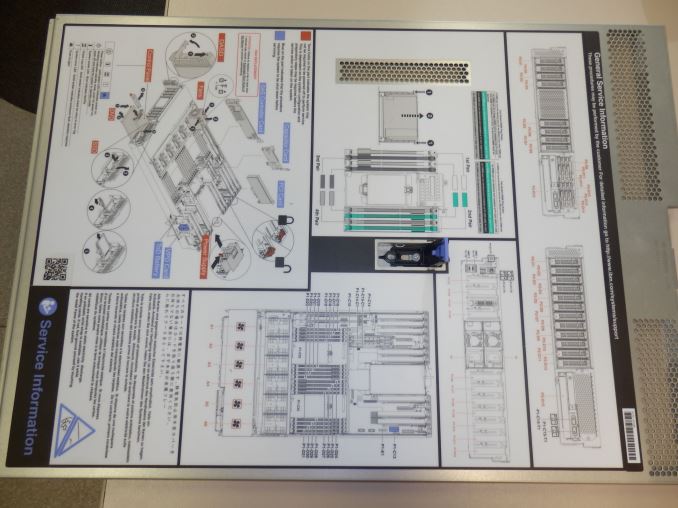
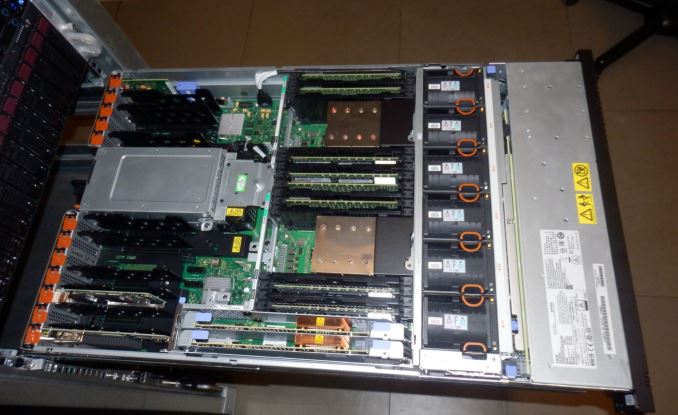
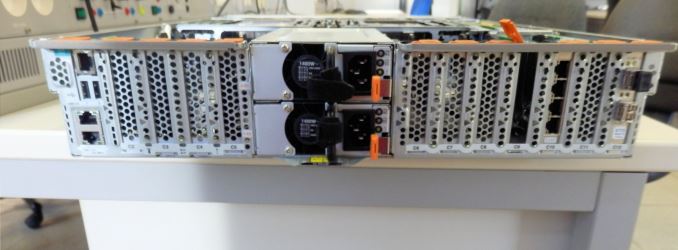
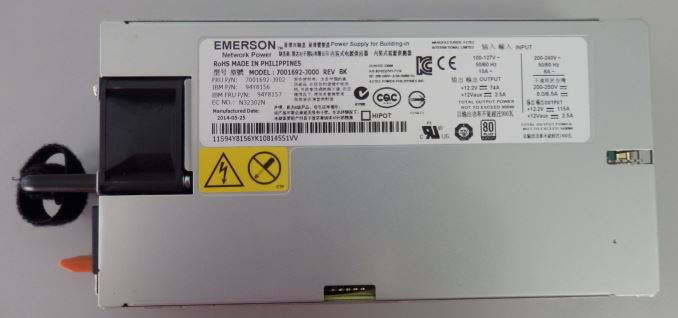








146 Comments
View All Comments
psychobriggsy - Friday, November 6, 2015 - link
So you are complaining that your job's selection of hardware has made you earn twice as much?dgingeri - Friday, November 6, 2015 - link
No, because I don't earn twice as much. I'm not fully trained in AIX, so I have to muddle my way through dealing with the test machines we have. We don't use them for full production machines, just for testing software for our customers. (Which means I have to reinstall the OS on at least one of those machines about every month or so. That is a BIG pain in the behind due to the boot procedure. Where it takes a couple hours to reinstall Windows or Linux, it takes a full day to do it on an AIX machine.)I'm trying to advise people to NOT use AIX. It's an awful operating system. I'm also advising people NOT use IBM Power based machines because they are extremely aggravating to work on. Overall, it costs much more to run IBM Power machines, even if they aren't running AIX, than it does to run x86 machines. The up front cost might look competitive, but the maintenance costs are huge. Running AIX on them makes it an order of magnitude more expensive.
serpint - Friday, November 6, 2015 - link
I suggest reading the NIM A-Z handbook. It shouldn't take you more than 10 minutes to fully deploy an AIX system fully built and installed with software. As with Linux, it also shouldn't take more than about 10 minutes to install and fully deploy a server if you have any experience scripting installs.The developerworks community inside IBM is possibly the best free resource you could hope for. Also the redbooks.ibm.com site.
Compared to most *NIX flavors, AIX is UNIX for dummies.
agtcovert - Tuesday, November 10, 2015 - link
If you had a NIM server setup and were using LPARs, loading a functional image of AIX should take 10 minutes flat, on a 1G network.If you're loading AIX on a physical machine without using the virtualization, you're wasting the server.
agtcovert - Tuesday, November 10, 2015 - link
I've worked on AIX platforms extensively for about the same amount of time. First, most of these purchases go through a partner and yours must've sucked because we got great support from our IBM partner -- free training, access to experts, that sort of thing.Second, I always love the complaining about the cost of the hardware, etc. If you're buying big iron Power servers, the maintenance cost should be near irrelevant. And again, your partner should take care to negotiate that into the deal for 3-5 years ensuring you have access to updates.
The other thing no one ever talks about is *why* you buy these servers. Why do they take so long to boot? Well, for the frame it self, it's a deep POST. But then, mine were never rebooted in 4 years, and that's for firmware upgrades (online) and a couple of interface card swaps (also done online with no service disruption). Do that on x86. So reason #1 -- RAS, at the hardware level. Seriously, how often did you need to reboot the frame?
Reason #2 -- for large enterprises, you can do so much with these with relatively few cores they lead to huge licensing savings in Oracle, IBM software. For us, it was over $1m a year ongoing. And no, switching to other software was not an option. We could run an Oracle RAC on 4 cores of Power 7 (at the time) versus the 32 x86 it was on previously. That saves a lot of $.
The machine reviewed does not run AIX. It's Linux only. So the maintenance, etc. you mention isn't even relevant.
There are still things that are annoying I suppose. AIX is steeped in legacy to some degree, and certainly not as easy to manage as a Linux box. But there are a lot of guides out there for free -- it took me about a month to be fully productive. And the support costs you pay for -- well, if I ran into a wall, I just opened a PMR. IBM was always helpful
nils_ - Wednesday, November 11, 2015 - link
I'm mostly working in Linux Devops now, but I remember dreading to use all the "classic" Unix machines at my first "real" job 12 years ago. We ran a few IRIX and AIX boxes which were ancient along itself. Hell even the first thing I did on my work Macbook was to replace the BSD userland with GNU wherever possible.It's hard to find any information on them and any learning materials are expensive and usually on dead trees. They pretty much want to sell training, consulting etc. along with the often non-competitive Hardware prices since these companies don't actually WANT to sell hardware. They want to sell everything that surrounds it.
retrospooty - Friday, November 6, 2015 - link
The problem with server chips is that its about platform stability. IBM (and others) dropped off the face of the Earth and as mentioned above Intel now has 95% of the market. This chip looks great but will companies buy into it in mass? What if IBM makes another choice to drop off the face of the Earth again and your platform is dead ended? I would have to think long and hard about going with them at this point.FunBunny2 - Friday, November 6, 2015 - link
Not likely. the mainframe z machines are built using POWER blocks.Kevin G - Friday, November 6, 2015 - link
POWER and System Z are two different architectures. Case in point, POWER is a RISC design introduced in the 90's where as the System Z mainframes can trace their roots to a CISC design from the 1960's (and it is still possible to run some of that 1960's code unmodified).They do share a handful of common parts (think the CDIMMs) to cut down on support costs.
plonk420 - Friday, November 6, 2015 - link
can you run an x264 benchmark on it?? x)